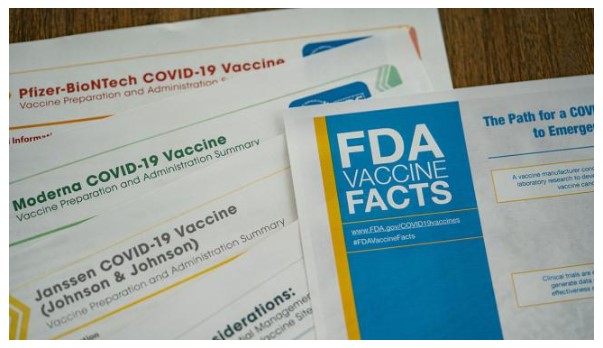COVID-19: The Food and Drug Administration of the United States has authorized updated labeling for two mRNA COVID-19 vaccines (Comirnaty; Pfizer and Spikevax; Moderna) that highlight the potential risk of myocarditis and pericarditis.
Both vaccines have consistently included warnings on their labels regarding the possible risks associated with this side effect, emphasizing that the risk is greatest during the first week after vaccination and that it is more common in males aged 12 to 24 years. The revised safety information will now incorporate the estimated unadjusted occurrence of myocarditis and/or pericarditis following the administration of the 2023-2024 vaccines.
The revised wording will indicate that the projected occurrence in the week following vaccination is around eight instances of myocarditis and/or pericarditis per 1 million doses among individuals aged 6 months to 64 years. For males aged 12 to 24 years, the raw incidence is around 27 cases per 1 million doses. This incidence figure is derived from health insurance claims data covering both inpatient and outpatient situations, as reported by the FDA.
Furthermore, the labels will incorporate follow-up information regarding patients who were hospitalized due to myocarditis associated with the COVID-19 vaccine.
The information comes from a longitudinal research study involving 333 patients who experienced myocarditis following vaccination and underwent cardiac magnetic resonance (CMR) imaging. In this study, the initial presentation of myocarditis was classified as “mild,” and the majority of patients demonstrated favorable midterm outcomes; however, more than 80% still exhibited signs of myocardial injury, indicated by the presence of late gadolinium enhancement nearly six months after their diagnosis. The updated label will indicate that the “clinical and prognostic significance of the CMR findings is unknown.”
Both Pfizer and Moderna are conducting long-term studies to evaluate the clinical effects of myocarditis associated with the vaccine, as stated by the agency.

FAQ:
Are the mRNA vaccines approved by the FDA?
Yes, mRNA vaccines are approved by the FDA. The U.S. Food and Drug Administration (FDA) has fully approved mRNA COVID-19 vaccines, including the Pfizer-BioNTech and Moderna vaccines. These vaccines underwent rigorous testing and met the FDA’s high standards for safety, effectiveness, and manufacturing quality. Initially granted Emergency Use Authorization (EUA), both vaccines have since received full FDA approval for use in various age groups. This approval confirms their role as safe and effective tools in preventing COVID-19 and its complications.
Do COVID vaccines still use mRNA?
Yes, many COVID-19 vaccines still use mRNA technology. The Pfizer-BioNTech and Moderna vaccines continue to be based on mRNA, a cutting-edge platform that teaches the body to recognize and fight the virus that causes COVID-19. These mRNA vaccines have been updated over time to target new variants and remain among the most widely used and effective options. While other COVID-19 vaccines using different technologies (like protein-based or viral vector vaccines) are also available, mRNA vaccines remain a key tool in ongoing global vaccination efforts.
Is the mRNA COVID vaccine safe?
Yes, the mRNA COVID-19 vaccine is considered safe and effective. Both the Pfizer-BioNTech and Moderna mRNA vaccines have undergone extensive clinical trials and real-world studies, demonstrating a strong safety profile. They have been approved by the U.S. Food and Drug Administration (FDA) and other global health authorities for use in various age groups. Like all vaccines, mRNA COVID vaccines may cause mild side effects such as soreness at the injection site, fatigue, or fever, which typically resolve within a few days. Serious side effects are extremely rare. Overall, mRNA vaccines offer strong protection against COVID-19 and its severe complications.
When did COVID-19 start in Bangladesh?
- COVID is now endemic, not a pandemic
- The World Health Organization officially ended the global Public Health Emergency in May 2023, treating COVID as an endemic disease—similar to seasonal flu.
- Virus activity is ongoing
- Since mid‑February 2025, global COVID test positivity has climbed to about 11 %, reaching levels not seen since July 2024—especially in South‑East Asia, Eastern Mediterranean, and Western Pacific regions.
- New variants are active
- Several Omicron subvariants—including NB.1.8.1 (aka “Nimbus”), XEC, LP.8.1, XFG/XFC, and JN.1—are currently circulating
- In the U.S., Nimbus has become the dominant strain, causing an estimated 43 % of cases by late June 2025
- In Bangladesh, positivity rates climbed from ~9 % in May to ~20 % in June 2025, driven by XFG, XFC, JN.1, NB.1.8.1, and BA.2.86
- Severity remains mostly mild
- Current variants aren’t causing more severe disease than earlier omicron forms. Most infections show mild, flu‑like symptoms: sore throat, cough, fatigue, sometimes gastrointestinal upset
- Hospitalizations and deaths persist in vulnerable populations, but overall severity remains lower.
- Public health advice now centers on vigilance
- WHO continues to rate COVID risk as high, recommending ongoing testing, monitoring, vaccination (especially for at-risk groups), and integrating COVID surveillance into general respiratory care programs
- U.S. experts still advocate masking, hand hygiene, and updated vaccines targeting new variants like JN.1


